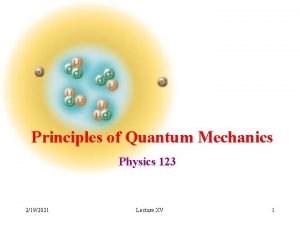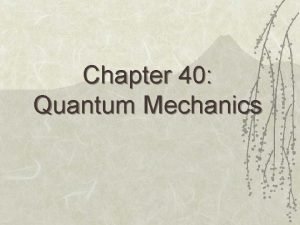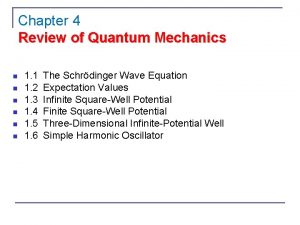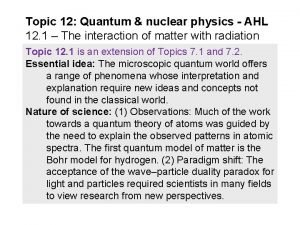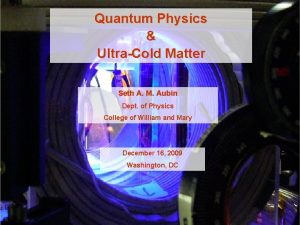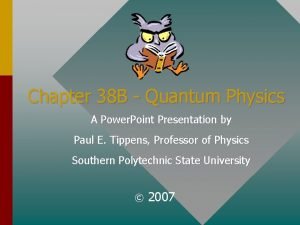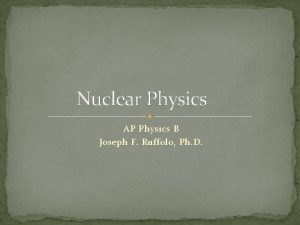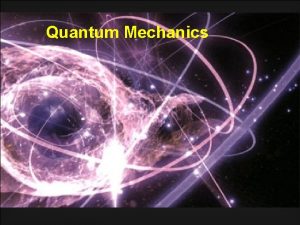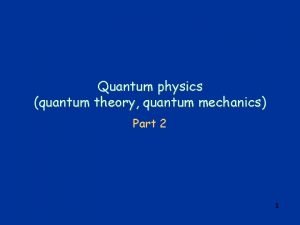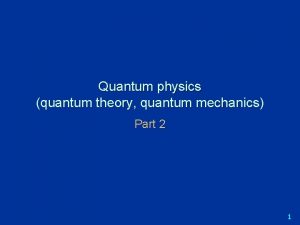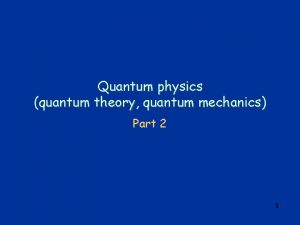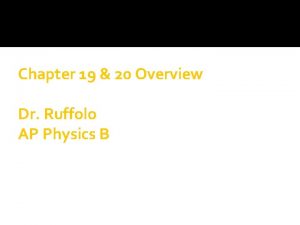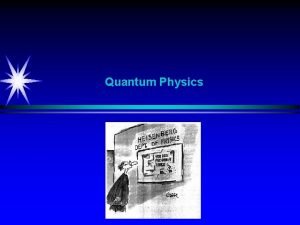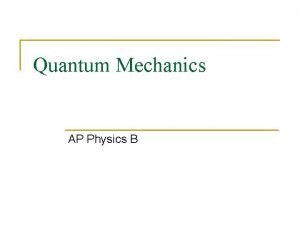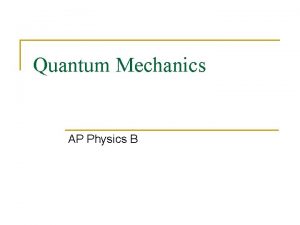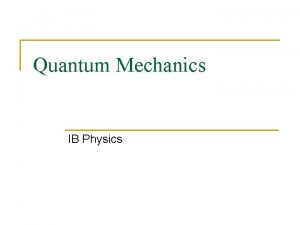Quantum Physics Part 1 AP Physics J Ruffolo













- Slides: 13

Quantum Physics Part 1 AP Physics – J. Ruffolo, Ph. D.

Plank’s Constant In his studies of black-body radiation, Maxwell Planck discovered that electromagnetic energy is emitted or absorbed in discrete quantities. Planck’s Equation: E = hf (h = 6. 626 x 10 Apparently, light consists of tiny bundles of energy called photons, each having a welldefined quantum of energy. -34 J s) Photon E = hf

Energy in Electron-volts Photon energies are so small that the energy is better expressed in terms of the electron-volt. One electron-volt (e. V) is the energy of an electron when accelerated through a potential difference of one volt. 1 e. V = 1. 60 x 10 -19 J 1 ke. V = 1. 6 x 10 -16 J 1 Me. V = 1. 6 x 10 -13 J

Example 1: What is the energy of a photon of yellow-green light (l = 555 nm)? First we find f from wave equation: c = fl E = 3. 58 x 10 -19 J Or Since 1 e. V = 1. 60 x 10 -19 J E = 2. 24 e. V

Useful Energy Conversion Since light is often described by its wavelength in nanometers (nm) and its energy E is given in e. V, a conversion formula is useful. (1 nm = 1 x 10 -9 m) If l is in nm, the energy in e. V is found from: Verify the answer in Example 1. . .

The Photo-Electric Effect Incident light Cathode C - Anode A + When light shines on the cathode C of a photocell, electrons are ejected from A and attracted by the positive potential due to battery. Ammeter A There is a certain threshold energy, called the work function W, that must be overcome before any electrons can be emitted.

Photo-Electric Equation Incident light Cathode C - Anode A + Ammeter Threshold wavelength lo A The conservation of energy demands that the energy of the incoming light hc/l be equal to the work function W of the surface plus the kinetic energy ½mv 2 of the emitted electrons.

Example 2: The threshold wavelength of light for a given surface is 600 nm. What is the kinetic energy of emitted electrons if light of wavelength 450 nm shines on the metal? l = 600 nm A ; K = 2. 76 e. V – 2. 07 e. V K = 0. 690 e. V Or K = 1. 10 x 10 -19 J

Stopping Potential A potentiometer is used to vary to the voltage V between the electrodes. The stopping potential is that voltage Vo that just stops the emission of electrons, and thus equals their original K. E. Incident light Cathode Anode V A + Potentiometer Kmax = e. Vo Photoelectric equation: -

Slope of a Straight Line (Review) The general equation for a straight line is: The slope of a line: y y = mx + b The x-intercept xo occurs when line crosses x axis or when y = 0. The slope of the line is the rise over the run: Slope y x xo x

Finding Planck’s Constant, h Using the apparatus on the previous slide, we determine the stopping potential for a number of incident light frequencies, then plot a graph. Finding h constant Stopping potential V Slope fo Note that the x-intercept fo is the threshold frequency. y x Frequency

Example 3: In an experiment to determine Planck’s constant, a plot of stopping potential versus frequency is made. The slope of the curve is 4. 13 x 10 -15 V/Hz. What is Planck’s constant? Stopping potential V Slope fo y x Frequency h = e(slope) = (1. 6 x 10 -19 C)(4. 13 x 10 -15 V/Hz) Experimental Planck’s h = 6. 61 x 10 -34 J/Hz

Example 4: The threshold frequency for a given surface is 1. 09 x 1015 Hz. What is the stopping potential for incident light whose photon energy is 8. 48 x 10 -19 J? Photoelectric Equation: Incident light Cathode Anode V A + - W = (6. 63 x 10 -34 Js)(1. 09 x 1015 Hz) =7. 20 x 10 -19 J Stopping potential: Vo = 0. 800 V
 Origin of quantum mechanics
Origin of quantum mechanics Quantum physics vs mechanics
Quantum physics vs mechanics Physics topic 12
Physics topic 12 Quantum physics wave function
Quantum physics wave function Pn junction khan academy
Pn junction khan academy Beta decay
Beta decay Quantum physics wave function
Quantum physics wave function Quantum physics wave function
Quantum physics wave function Quantum nuclear physics
Quantum nuclear physics Quantum physics summary
Quantum physics summary Quantum physics summary
Quantum physics summary Quantum physics in hindi
Quantum physics in hindi Addition symbol
Addition symbol Unit ratio definition
Unit ratio definition



